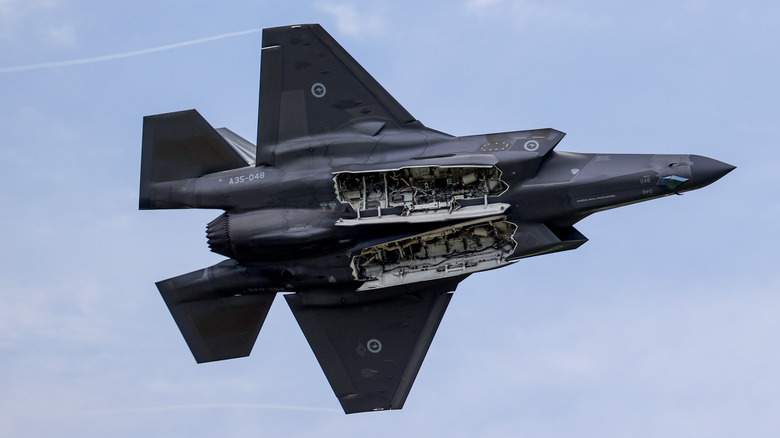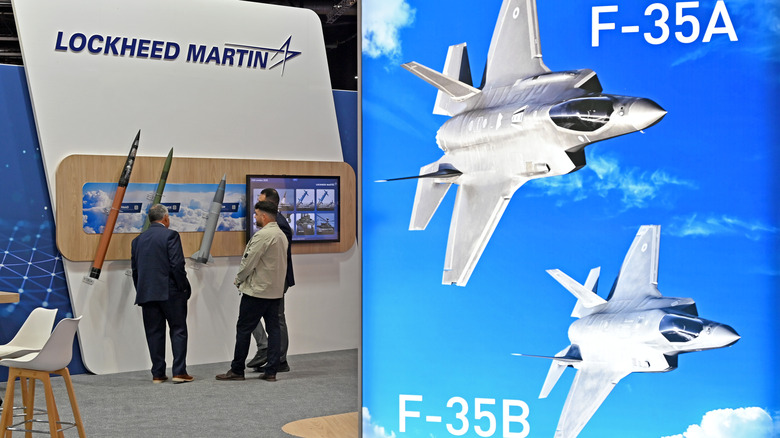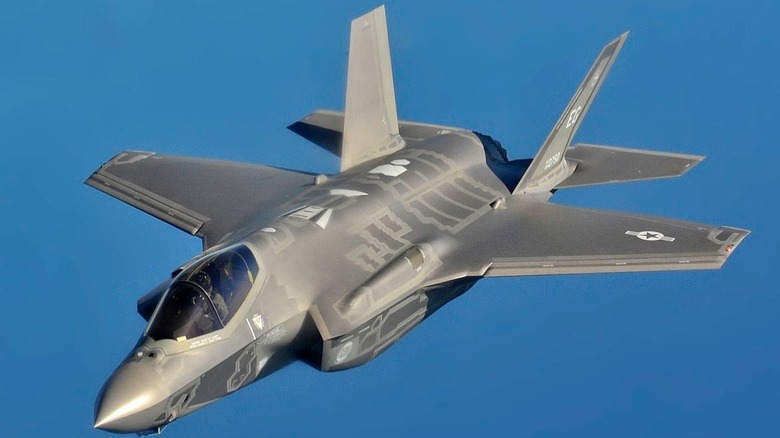This Is The Only F35 Variant That's Nuclear Capable: Here's What Makes It Different
Fighter jets are some of the most astonishing aircraft in the sky. From the blazing pace of the F-15 Eagle to the advanced armaments of Russia's Sukhoi Su-35, these aircraft are known for their maneuverability and firepower in equal measure. However, for the sake of international deterrence as well as attracting international business, continual advancement is very important for these jets. This is why many variations on certain models are released. They might simply entail a different engine or new weapons configuration, or they might fundamentally change the layout and functionality of an aircraft.
For instance, one variant may make a model a dual-seater, allowing for pilot training. The F-35 is an interesting case in that the first variant released, the F-35A, which joined the United States Air Force in 2011, is the only one capable of carrying nuclear weapons. It's one of the most advanced fighter jets in the world, and its versatility is one vital aspect of that. F-35 variants differ considerably.
The F-35B offers the capacity for short takeoff and vertical landing, while its counterpart is equipped only for conventional landings. The first variant has its own unique traits that allow it to equip nuclear weapons, because it's not as simple as keeping them on board. Choosing the F-35A as the vehicle to equip the B61 bomb was a complex process, requiring special certification on the aircraft's part and this variation's technical abilities, which better suit the mission of nuclear deterrence that the B61 is an integral part of.
The F-35A is capable of flight feats that other variants are not
These are highly sophisticated aircraft specialized for certain roles or abilities, and often, something has to be sacrificed in their design in order to emphasize something else. The F-35B's ability to perform STOVL maneuvers, the sole reason for the canopy closing from the front, gives it more versatility in terms of its landings. It also means that this variant's range isn't as great as the F-35A, because it isn't able to store as much fuel. Unique landings such as these require complicated mechanics, and the Shaft-Driven Lift Fan makes the aircraft significantly heavier and reduces its storage capacity. This feature boosts the aircraft's lift and allows it to perform its unique landings and takeoffs, but it also means that it only has about 66% the fuel supply that the F-35A does.
There's also the F-35C variant, designed to take off from aircraft carriers for the Navy. It has larger wings than the other two variants, is the heaviest of the three, and falls behind its counterparts in the power department, having a thrust-to-weight ratio of 0.75, compared to the F-35B's 0.90 and F-35A's 0.87.
In June 2025, the British Royal Air Force announced that it had acquired a dozen F-35A fighter jets and that it had some specific roles in mind for them. The first was to utilize their range as long-distance training aircraft for pilots. Secondly, it would serve "to fly NATO's nuclear mission in a crisis, deepening the U.K.'s contribution to NATO's nuclear burden-sharing arrangements." To do so, it can be equipped with a very specific nuclear weapon.
The nuclear weapon the F-35A can field
The F-35A's crucial contribution to nuclear deterrence, for both NATO and the U.K. itself, is/will be the B61-12 nuclear gravity bomb, which can be brilliantly concealed inside the F-35. The B61-12 is a powerful force, though not a particularly sophisticated one in terms of its mode of travel. The Guardian reports that these weapons function as "freefall explosives with limited guidance systems." Nonetheless, its planned presence in the United Kingdom is significant, as the Royal Air Force hasn't had a nuclear bomb that can be equipped by its aircraft since 1998. That year marked the end of the last WE177s, a nuclear bomb in three different variants (A, B, and C) that was first introduced in 1966.
The collective NATO strategy of nuclear deterrence requires a strict protocol for the gravity bombs to actually be deployed. A February 2022 NATO (link downloads a PDF to your device) fact sheet explains, "The United States has deployed a limited number of B-61 nuclear weapons to certain locations in Europe, which remain under U.S. custody and control." The U.S. President, along with the Prime Minister of the U.K. and NATO more broadly, would need to collaborate to approve any potential use of the weapons on the F-35As.
The British Government declared acquiring the jets to be "the biggest strengthening of the U.K.'s nuclear posture in a generation, complementing the U.K.'s existing sea-borne deterrent," but the move was about more than that. The initial dozen F-35s are mostly to serve in a training role, alongside the RAF's other models, but 138 of them are expected to be obtained in total through the deal going forward.


